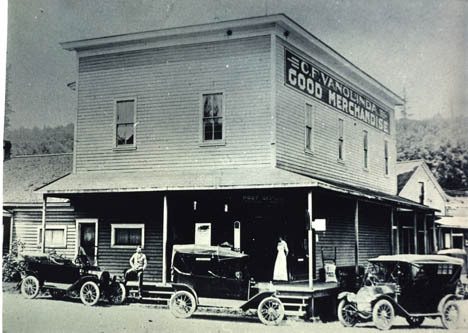Portage has long been an important and interesting part of Vashon-Maury Island, providing the link between what was once two islands.
The S’Homamish First People used Portage as a major gathering and hunting place and shared hunting rights at the site with the Nisqually First People in a traditional resource sharing arrangement. The bird netting poles at Portage were still visible as late as 1905.
Portage was also the site of a major S’Homamish burial area, with canoe burials in the large madrone grove to the south of the crossroad still present in the 1910s. The madrone grove has been largely eliminated, and nothing remains of the canoe burials except the spirits of the place.
Portage was mapped first by George Vancouver in 1792, who saw it as a connecting isthmus and named the island “Vashon’s Island,” and half a century later by Charles Wilkes of the American Exploring Expedition, who saw it as a tidal flat and thus two islands, naming Maury as a separate island after Lt. William Maury, the expedition’s navigator.
After American settlement of Vashon, the Portage Store became the center of a vibrant community with a Ford automobile dealership (the first auto dealership on Vashon), a post office, a hotel, an Episcopal church, and the first automobile ferry from Vashon to the mainland. Today, the store sits closed with residents on the upper floor and in the connected residence to the west.
In 1903, C.F. VanOlinda built the first store at Portage and later that year opened the Portage post office as its first postmaster. The store offered the first rural free delivery on the Island beginning in 1905, and remained a post office until July 12, 1968, when it was decommissioned.
The original store was moved to the north in 1906 when the present large two-story store was built. In 1916 the Portage-Des Moines automobile ferry route was opened at the Portage dock but was short-lived, closing in 1921 as auto traffic was moved to the north-end dock.
After VanOlinda sold the building, the store remained in operation well into the first years of the 21st century. Through the 1910s, the store had a number of different owners, ultimately becoming Lavender’s Store. Then in the late 1960s, Jim and Beth Smith operated it until it closed in 2005.
The store also changed physically through the years, as the top-right photograph, taken in 1916, shows. The original Portage Store, a portion of which one can see on the right-hand side of the new structure, was much smaller. The new store, meanwhile, also boasted an attached residence, which can be seen to the left of the two-story store.
The current photograph, taken in June 2009, shows that the siding, windows and covered porch area are virtually the same. The wooden porch and steps were replaced with poured concrete and the porch roof on the right side was shortened. Today a line of large, well-developed laurel covers the front of the store and the attached residence.
— Bruce Haulman is an Island historian who teaches history at Green River Community College. Terry Donnelly is a nationally recognized landscape photographer who’s lived on Vashon for many years.



